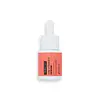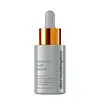What's inside
What's inside
 Key Ingredients
Key Ingredients

 Benefits
Benefits

 Concerns
Concerns

 Ingredients Side-by-side
Ingredients Side-by-side

Water
Skin ConditioningAscorbic Acid
AntioxidantPropanediol
SolventGlycerin
HumectantButylene Glycol
HumectantXanthan Gum
EmulsifyingPEG-40 Hydrogenated Castor Oil
EmulsifyingPolysorbate 20
EmulsifyingSodium Benzoate
MaskingTocopherol
AntioxidantPotassium Sorbate
PreservativeDisodium EDTA
Helianthus Annuus Seed Oil
EmollientStyrene/Acrylates Copolymer
Sodium Hydroxide
BufferingSodium Lauryl Sulfate
CleansingDisodium Laureth Sulfosuccinate
CleansingWater, Ascorbic Acid, Propanediol, Glycerin, Butylene Glycol, Xanthan Gum, PEG-40 Hydrogenated Castor Oil, Polysorbate 20, Sodium Benzoate, Tocopherol, Potassium Sorbate, Disodium EDTA, Helianthus Annuus Seed Oil, Styrene/Acrylates Copolymer, Sodium Hydroxide, Sodium Lauryl Sulfate, Disodium Laureth Sulfosuccinate
Water
Skin ConditioningGlycerin
HumectantPropanediol
SolventTranexamic Acid
AstringentButylene Glycol
HumectantPEG-40 Hydrogenated Castor Oil
EmulsifyingAminopropyl Ascorbyl Phosphate
AntioxidantHydroxyacetophenone
AntioxidantDipotassium Glycyrrhizate
HumectantLactic Acid
BufferingErgothioneine
AntioxidantGlycine Soja Oil
EmollientHelianthus Annuus Seed Oil
EmollientCitrus Nobilis Peel Oil
MaskingRicinus Communis Seed Oil
MaskingChlorella Vulgaris Extract
Skin ConditioningDaucus Carota Sativa Root Extract
Skin ConditioningHydrolyzed Jojoba Esters
Skin ConditioningCichorium Intybus Root Extract
MaskingOpuntia Ficus-Indica Stem Extract
Skin ConditioningCitrus Aurantium Dulcis Fruit Extract
MaskingCitrus Paradisi Fruit Extract
Skin ConditioningCitrus Aurantifolia Oil
CleansingCyamopsis Tetragonoloba Gum
Emulsion StabilisingTocopherol
AntioxidantSodium PCA
HumectantFructooligosaccharides
HumectantBioflavonoids
Skin ConditioningGlycoproteins
Skin ConditioningGlycine
BufferingSqualane
EmollientAscorbyl Methylsilanol Pectinate
AntioxidantCaprylyl Glycol
EmollientBeta-Carotene
Skin ConditioningCystine
MaskingPentylene Glycol
Skin ConditioningMannitol
HumectantErgosterol
Skin ConditioningXanthan Gum
EmulsifyingMethylpropanediol
Solvent1,2-Hexanediol
Skin ConditioningTetrasodium Glutamate Diacetate
Carbomer/Papain Crosspolymer
Phytic Acid
Citric Acid
BufferingSodium Hydroxide
BufferingAcacia Senegal Gum
MaskingPolyacrylate Crosspolymer-6
Emulsion StabilisingAlgin
MaskingDisodium Phosphate
BufferingLimonene
PerfumingCitrus Species Peel Extract
PerfumingWater, Glycerin, Propanediol, Tranexamic Acid, Butylene Glycol, PEG-40 Hydrogenated Castor Oil, Aminopropyl Ascorbyl Phosphate, Hydroxyacetophenone, Dipotassium Glycyrrhizate, Lactic Acid, Ergothioneine, Glycine Soja Oil, Helianthus Annuus Seed Oil, Citrus Nobilis Peel Oil, Ricinus Communis Seed Oil, Chlorella Vulgaris Extract, Daucus Carota Sativa Root Extract, Hydrolyzed Jojoba Esters, Cichorium Intybus Root Extract, Opuntia Ficus-Indica Stem Extract, Citrus Aurantium Dulcis Fruit Extract, Citrus Paradisi Fruit Extract, Citrus Aurantifolia Oil, Cyamopsis Tetragonoloba Gum, Tocopherol, Sodium PCA, Fructooligosaccharides, Bioflavonoids, Glycoproteins, Glycine, Squalane, Ascorbyl Methylsilanol Pectinate, Caprylyl Glycol, Beta-Carotene, Cystine, Pentylene Glycol, Mannitol, Ergosterol, Xanthan Gum, Methylpropanediol, 1,2-Hexanediol, Tetrasodium Glutamate Diacetate, Carbomer/Papain Crosspolymer, Phytic Acid, Citric Acid, Sodium Hydroxide, Acacia Senegal Gum, Polyacrylate Crosspolymer-6, Algin, Disodium Phosphate, Limonene, Citrus Species Peel Extract
Ingredients Explained
These ingredients are found in both products.
Ingredients higher up in an ingredient list are typically present in a larger amount.
Butylene Glycol (or BG) is used within cosmetic products for a few different reasons:
Overall, Butylene Glycol is a safe and well-rounded ingredient that works well with other ingredients.
Though this ingredient works well with most skin types, some people with sensitive skin may experience a reaction such as allergic rashes, closed comedones, or itchiness.
Learn more about Butylene GlycolGlycerin is already naturally found in your skin. It helps moisturize and protect your skin.
A study from 2016 found glycerin to be more effective as a humectant than AHAs and hyaluronic acid.
As a humectant, it helps the skin stay hydrated by pulling moisture to your skin. The low molecular weight of glycerin allows it to pull moisture into the deeper layers of your skin.
Hydrated skin improves your skin barrier; Your skin barrier helps protect against irritants and bacteria.
Glycerin has also been found to have antimicrobial and antiviral properties. Due to these properties, glycerin is often used in wound and burn treatments.
In cosmetics, glycerin is usually derived from plants such as soybean or palm. However, it can also be sourced from animals, such as tallow or animal fat.
This ingredient is organic, colorless, odorless, and non-toxic.
Glycerin is the name for this ingredient in American English. British English uses Glycerol/Glycerine.
Learn more about GlycerinHelianthus Annuus Seed Oil is the oil derived from the seeds of a Sunflower. Sunflower seed oil is non-fragrant. It is an emollient, meaning it helps to soften the skin.
Sunflower seed oil contains many fatty acids. The fatty acids found in sunflower seeds include (from highest amount to least): linoleic acid, myristic acid, palmitic acid, stearic acid, arachidic acid, oleic acid, and linolenic acid.
These fatty acids help the skin create ceramides. Ceramides play a role in repairing the skin barrier.
Helianthus Annuus Seed Oil helps moisturize the skin. This in turn helps the skin look more rejuvenated and smoother.
Sunflowers are rich in vitamin E.
Historians believe Indigenous cultures of North America domesticated sunflowers before corn. Thus they relied on sunflower oil for a variety of uses. One such use is moisturizing skin and hair.
Sunflower seed oil may not be fungal acne safe. We recommend speaking with a professional if you have any concerns.
Learn more about Helianthus Annuus Seed OilPeg-40 Hydrogenated Castor Oil is derived from castor oil and polyethylene glycol (PEG). It is used as a emollient and emulsifier.
As an emulsifier, it helps prevent ingredients from separating. It also helps make the other ingredients more soluble; it is often used to solubilize fragrances. This increases spreadability and elongates shelf life in a product.
Emollients help soothe and soften the skin. They do this by creating a protective film on your skin. This barrier helps trap moisture and keeps your skin hydrated. Emollients may be effective at treating dry or itchy skin.
This ingredient may or may not be vegan, depending on the source.
Peg-40 Hydrogenated Castor Oil may not be fungal-acne safe. We recommend speaking with a professional if you have any questions or concerns.
Learn more about PEG-40 Hydrogenated Castor OilPropanediol is an all-star ingredient. It softens, hydrates, and smooths the skin.
It’s often used to:
Propanediol is not likely to cause sensitivity and considered safe to use. It is derived from corn or petroleum with a clear color and no scent.
Learn more about PropanediolSodium Hydroxide is also known as lye or caustic soda. It is used to adjust the pH of products; many ingredients require a specific pH to be effective.
In small amounts, sodium hydroxide is considered safe to use. However, large amounts may cause chemical burns due to its high alkaline.
Your skin has a natural pH and acid mantle. This acid mantle helps prevent harmful bacteria from breaking through. The acid mantle also helps keep your skin hydrated.
"Alkaline" refers to a high pH level. A low pH level would be considered acidic.
Learn more about Sodium HydroxideTocopherol (also known as Vitamin E) is a common antioxidant used to help protect the skin from free-radicals and strengthen the skin barrier. It's also fat soluble - this means our skin is great at absorbing it.
Vitamin E also helps keep your natural skin lipids healthy. Your lipid skin barrier naturally consists of lipids, ceramides, and fatty acids. Vitamin E offers extra protection for your skin’s lipid barrier, keeping your skin healthy and nourished.
Another benefit is a bit of UV protection. Vitamin E helps reduce the damage caused by UVB rays. (It should not replace your sunscreen). Combining it with Vitamin C can decrease sunburned cells and hyperpigmentation after UV exposure.
You might have noticed Vitamin E + C often paired together. This is because it is great at stabilizing Vitamin C. Using the two together helps increase the effectiveness of both ingredients.
There are often claims that Vitamin E can reduce/prevent scarring, but these claims haven't been confirmed by scientific research.
Learn more about TocopherolWater. It's the most common cosmetic ingredient of all. You'll usually see it at the top of ingredient lists, meaning that it makes up the largest part of the product.
So why is it so popular? Water most often acts as a solvent - this means that it helps dissolve other ingredients into the formulation.
You'll also recognize water as that liquid we all need to stay alive. If you see this, drink a glass of water. Stay hydrated!
Learn more about WaterXanthan gum is used as a stabilizer and thickener within cosmetic products. It helps give products a sticky, thick feeling - preventing them from being too runny.
On the technical side of things, xanthan gum is a polysaccharide - a combination consisting of multiple sugar molecules bonded together.
Xanthan gum is a pretty common and great ingredient. It is a natural, non-toxic, non-irritating ingredient that is also commonly used in food products.
Learn more about Xanthan Gum